Family name: Pontederiaceae K. Kunth
Synonym(s): Heterantheraceae J. Agardh
Common name(s): water-hyacinth family
*Number of genera/species: 6/34
List of genera records in GRIN-Global
fruit or seed
Fruit dehiscentdehiscent:
(v. dehisce) splitting open at maturity to release contents (of a fruit)
 , loculicidalloculicidal:
, loculicidalloculicidal:
type of capsular dehiscence, opening longitudinally through the locules (compare septicidal)
 capsulecapsule:
capsulecapsule:
a dry, dehiscent fruit formed by two or more carpels
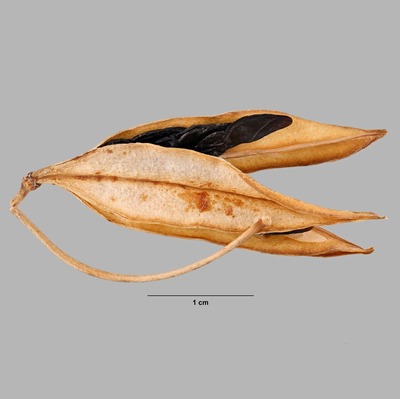 or sometimes indehiscentindehiscent:
or sometimes indehiscentindehiscent:
not opening on its own, as in a fruit
 , utricleutricle:
, utricleutricle:
a small, indehiscent, dry fruit with a thin wall (bladderlike) that is loose and free from the seed
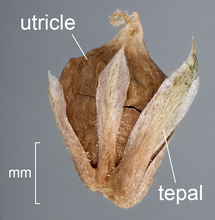 or acheneachene:
or acheneachene:
a dry, indehiscent, one-seeded fruit, with seed attached to pericarp at a single point
 , 1–18 mm long, linearlinear:
, 1–18 mm long, linearlinear:
(shape) long, narrow, and uniform in width; (of embryo) embryo is straight and much longer than wide
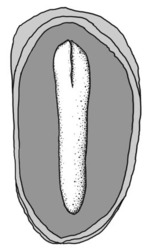 to trigonoustrigonous:
to trigonoustrigonous:
3D shape—having three faces that meet at distinct angles; triangular in outline
, angledangled:
2D shape—having sides that meet at acute or obtuse angles
in transectiontransection:
a cross section; representing a plane made by cutting across an organ at a right angle to its length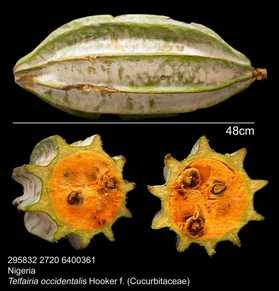 , with stylar remnantsstylar remnants:
, with stylar remnantsstylar remnants:
remnant of a style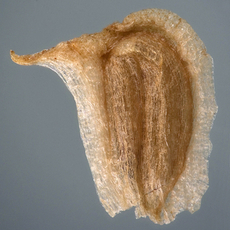 , sometimes winged, one seeded (Pontederia, Reussia) or many seeded. Pericarppericarp:
, sometimes winged, one seeded (Pontederia, Reussia) or many seeded. Pericarppericarp:
fruit wall or fruit coat
brown, membranousmembranous:
texture—extremely thin, pliable, and fairly tough
, chartaceouschartaceous:
=papery, papyraceous
, or indurateindurate:
texture—hardened or stony; yielding under strong pressure; not deformable without internal structural disruption
, ridgedridged:
surface relief—raised, thick ridges, sharp edged or rounded, usually in a series that may cover the entire surface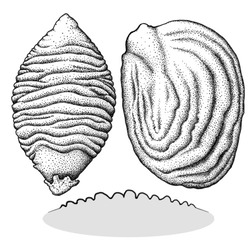 . Fruits are often shed before they open with seeds maturing in submerged capsulescapsules:
. Fruits are often shed before they open with seeds maturing in submerged capsulescapsules:
a dry, dehiscent fruit formed by two or more carpels
 . In Pontederia and Reussia, achenesachenes:
. In Pontederia and Reussia, achenesachenes:
a dry, indehiscent, one-seeded fruit, with seed attached to pericarp at a single point
 are surrounded by accrescentaccrescent:
are surrounded by accrescentaccrescent:
growing continuously
tepals that are hardened and ridgedridged:
surface relief—raised, thick ridges, sharp edged or rounded, usually in a series that may cover the entire surface , sometimes spinyspiny:
, sometimes spinyspiny:
having slender, stiff, sharp projections oriented in the general plane of the structure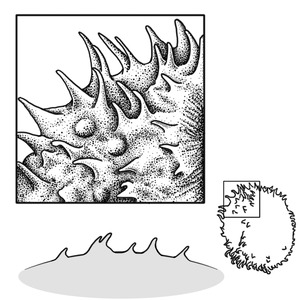 .
.
Seed globoseglobose:
3D shape—more or less spherical
 to reniformreniform:
to reniformreniform:
2D or 3D shape—kidney-shaped
 , tereteterete:
, tereteterete:
approximately circular in cross section; width and thickness approximately equal
 in transectiontransection:
in transectiontransection:
a cross section; representing a plane made by cutting across an organ at a right angle to its length , 0.5–2.1 mm long. Seed coat brown, thinthin:
, 0.5–2.1 mm long. Seed coat brown, thinthin:
having or being of relatively little depth
, smooth or if seeds from genera with capsulescapsules:
a dry, dehiscent fruit formed by two or more carpels
 , then usually longitudinally ribbedribbed:
, then usually longitudinally ribbedribbed:
surface relief—wide, prominent, linear ridges that are generally rounded and longitudinally situated on the surface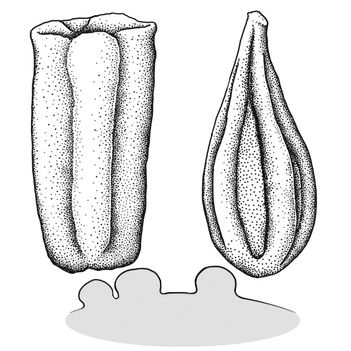 to winged, sometimes with persistent funiculusfuniculus:
to winged, sometimes with persistent funiculusfuniculus:
(alt. funicle) stalk connecting the ovule (later seed) to the ovary (later fruit) placenta
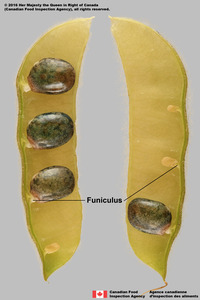 .
.
Embryo well developed, cylindricalcylindrical:
3D shape—a cylinder, with parallel sides and a circular cross-section; tubular or rod-shaped
, straight, the length of the seed or nearly so. Endospermendosperm:
nutritive starch- and oil-containing tissue present in many seeds
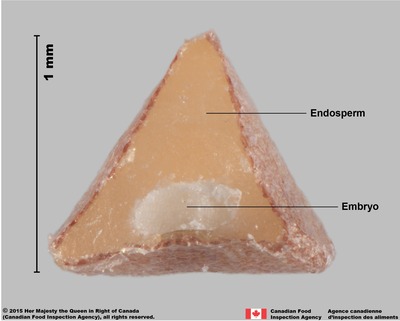 copious, mealymealy:
copious, mealymealy:
loose, dry, and disintegrating in finely granular
pieces like meal or flour
.
| Fruit | |
| Type | capsule, utricleutricle: a small, indehiscent, dry fruit with a thin wall (bladderlike) that is loose and free from the seed  , achene , achene |
| Size range | 1–18 mm long |
| Shape(s) | ovoid, oblongoblong: 2D shape—much longer than broad with nearly parallel sides, corners are rounded  , linearlinear: , linearlinear:(shape) long, narrow, and uniform in width; (of embryo) embryo is straight and much longer than wide  , fusiformfusiform: , fusiformfusiform:spindle-shaped; broadest at the middle and tapering at both ends 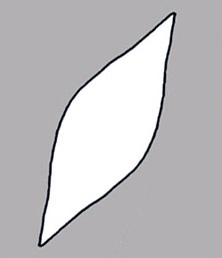 , trigonoustrigonous: , trigonoustrigonous:3D shape—having three faces that meet at distinct angles; triangular in outline , ellipsoidellipsoid: 3D shape—elliptic , globoseglobose: 3D shape—more or less spherical  , teardrop-shaped , teardrop-shaped |
| Texture | membranous, chartaceouschartaceous: =papery, papyraceous , indurate |
| Surface relief | ridgedridged: surface relief—raised, thick ridges, sharp edged or rounded, usually in a series that may cover the entire surface  |
| Color(s) | brown |
| Seed | |
| Size range | 0.5–2.1 mm long |
| Shape(s) | ovoid, reniformreniform: 2D or 3D shape—kidney-shaped  , oblongoblong: , oblongoblong:2D shape—much longer than broad with nearly parallel sides, corners are rounded  , ellipsoidellipsoid: , ellipsoidellipsoid:3D shape—elliptic , globose |
| Surface relief | ribbed, ridgedridged: surface relief—raised, thick ridges, sharp edged or rounded, usually in a series that may cover the entire surface  , reticulatereticulate: , reticulatereticulate:surface relief—netted, raised walls or concave grooves forming a net-like surface pattern with flat, concave, or convex interspaces  , striate , striate |
| Color(s) | brown |
| Unique features | Seeds small, longitudinally ribbedribbed: surface relief—wide, prominent, linear ridges that are generally rounded and longitudinally situated on the surface  to winged with relatively large embryo. to winged with relatively large embryo. |
| Other | |
| Embryo | well developed, cylindricalcylindrical: 3D shape—a cylinder, with parallel sides and a circular cross-section; tubular or rod-shaped , straight, length of the seed |
| Nutritive tissuenutritive tissue: tissue within the seeds that nourishes the developing embryo; such as endosperm, perisperm, or chalazosperm in angiosperms; megagametophyte in gymnosperms |
endosperm endosperm: nutritive starch- and oil-containing tissue present in many seeds  copious, mealy copious, mealy |
Tropics, with a few members in warm-temperate regions.
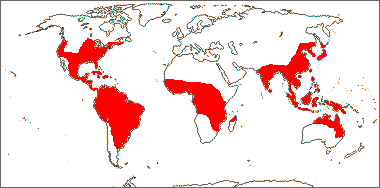
Distribution map courtesy of Angiosperm Phylogeny Website.
Baskin and Baskin 2021Baskin and Baskin 2021:
Baskin C and Baskin J. 2021. Relationship of the lateral embryo (in grasses) to other monocot embryos: A status up-grade. Seed Science Research 31 (3): 199-210. doi:10.1017/S0960258521000209; Dahlgren et al. 1985Dahlgren et al. 1985:
Dahlgren RMT, Clifford HT, and Yeo PF. 1985. The families of the monocotyledons: structure, evolution, and taxonomy. Springer-Verlag, Berlin. 520 pp.; Flora of Australia 2021+Flora of Australia 2021+:
Flora of Australia. Australian Biological Resources Study, Canberra. Accessed January-May 2021. URL: http://www.ausflora.org.au; Flora of North America Editorial Committee 1993+Flora of North America Editorial Committee 1993+:
Flora of North America Editorial Committee, eds. 1993+. Flora of North America North of Mexico [Online]. 22+ vols. Flora of North America Association, New York and Oxford. Accessed January-December 2021. URL: http://beta.floranorthamerica.org.; Kirkbride et al. 2006Kirkbride et al. 2006:
Kirkbride JH, Jr, Gunn CR, and Dallwitz MJ. 2006. Family guide for fruits and seeds, vers. 1.0. Accessed September 2020ndash;January 2022. URL: https://nt.ars-grin.gov/seedsfruits/keys/frsdfam/index.cfm .; Kubitzki et al. 1990+Kubitzki et al. 1990+:
Kubitzki K et al., eds. 1990+. The families and genera of vascular plants. 7+ vols. Berlin etc.; Pellegrini et al. 2018Pellegrini et al. 2018:
Pellegrini MOO, Horn CN, and Almeida RF. 2018. Total evidence phylogeny of Pontederiaceae (Commelinales) sheds light on the necessity of its recircumscription and synopsis of Pontederia L. PhytoKeys 83 (108): 25ndash;83. https://doi.org/10.3897/phytokeys.108.27652; Verdcourt 1968Verdcourt 1968:
Verdcourt B. 1968. Pontederiaceae. In: Milne-Redhead E and Polhill RM, eds. Flora of Tropical East Africa. Vol 149. Crown Agents for Oversea Governments and Administrations, London UK. 8 pp.; Zhengyi et al. 2004+Zhengyi et al. 2004+:
Zhengyi W, Raven PH, and Deyuan H. 2004+. Flora of China [online]. 25 vols. Science Press, Beijing China amp; Missouri Botanical Garden, St. Louis USA. Accessed January-December 2021. http://flora.huh.harvard.edu/china/; Zomlefer 1994Zomlefer 1994:
Zomlefer WB. 1994. Guide to Flowering Plant Families. The University of North Carolina Press, Chapel Hill. 430 pp.
*The number of genera and species is based on Christenhusz and Byng 2016Christenhusz and Byng 2016:
Christenhusz MJM and Byng JW. 2016. The number of known plant species in the world and its annual increase. Phytotaxa 261 (3): 201ndash;217. https://doi.org/10.11646/phytotaxa.261.3.1, which may differ from the number of genera in GRIN-Global.